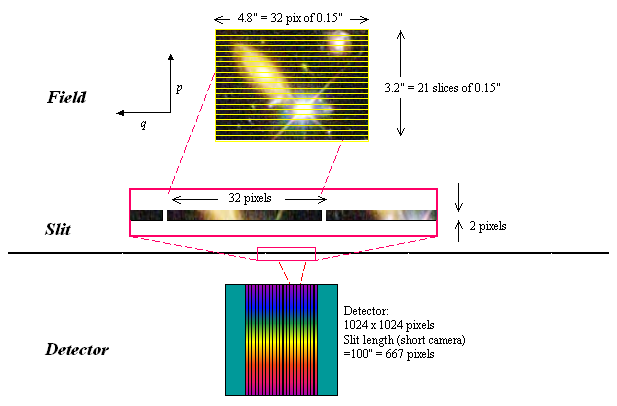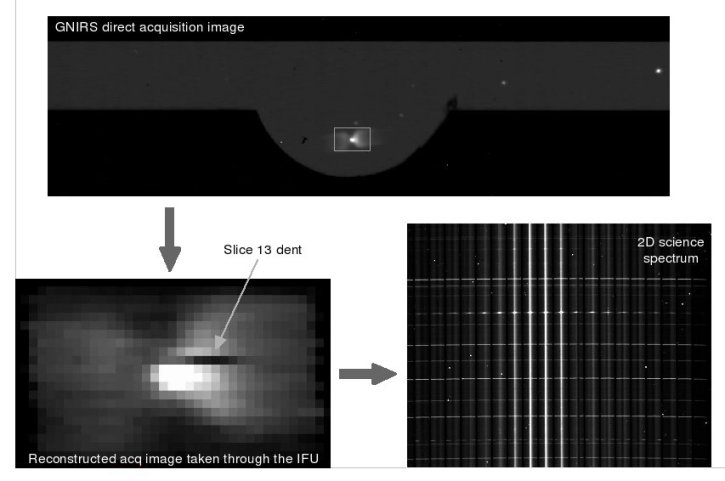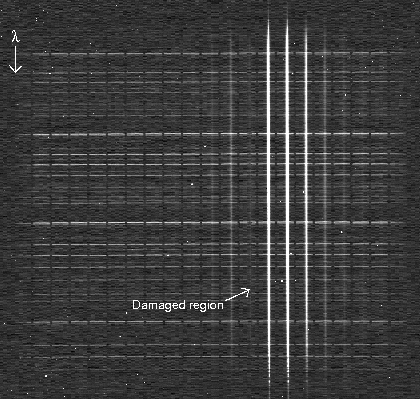Announcements
Note:The integral field unit was destroyed in 2007 in the accident that damaged GNIRS, and is no longer available.
The integral field unit (IFU) is an optical sub-system provided by the University of Durham (UK). It takes a rectangular input field, of approximately 3.2 x 4.8 arcsec, and divides it into 21 slices of width 0.15 arcsec. By re-arranging the slices end-to-end at the detector like a normal 1-D slit, the IFU allows images to be dispersed into full-length spectra whilst preserving the complete 2-D spatial information content. During data processing, it is possible to recover images at different wavelengths, spectra from different points, or a complete 3D "datacube".
| Spatial Sampling (IFU pixel) |
|
| Number of Slices |
|
| Field of View |
|
| Spectrum Length |
|
| Spectral slit width (FWHM) |
|
| GNIRS Camera Employed |
|
| Operating wavelength |
|
Figure 1: reformatting of the incident image by the IFU.

The IFU is installed permanently in the GNIRS slit slide and is therefore always available during GNIRS observing. It is inserted into the beam like a normal long slit, with light entering through a rectangular aperture at the front and leaving through a slit at the rear. The internal optics are all gold-coated reflective surfaces, carefully baffled to prevent stray or scattered light from entering the spectrograph. As well as reformatting the incident telescope image, the IFU introduces an anamorphic magnification such that each 0.15" wide slice projects onto 2 detector pixels in the dispersion direction (like the 0.3" long slit); this provides critical sampling of the spectral resolution element whilst still allowing the spatial pixels to be square. At the detector, the 21 image slices are divided along their length by the detector array to form the 0.15" square IFU elements. Gaps of a few pixels between adjacent slices allow the boundaries to be identified easily. The whole IFU is cooled to the same temperature as the rest of the instrument, allowing it to be used at thermal wavelengths (3-5 µm not offered in 2005A).
The optical throughput of the IFU alone (compared with a long slit) is approximately 70-90% from 1-2.5 µm. The values at thermal wavelengths are still to be verified.
The RMS throughput variation over the field is only 3%, except in slices 1,13 and 21. The two end slices are vignetted by the spectrograph and transmit ~35-55% as much light as the rest of the field. Slice 13 was damaged during assembly and has a region of reduced throughput 1.8 arcseconds in length, offset 0.5 arcseconds from the centre, where the transmission falls to ~20% of the nominal value. It is therefore recommended that science observations be defined with at least two offset positions on the sky (including a dither in p), to 'fill in' this defect near the field centre.
Further performance details will be added following more complete analysis of commissioning data. Signal-to-noise and flux estimates can be obtained using the GNIRS integration time calculator.
Target acquisition
Initial acquisition is done by taking a direct image of the target in the GNIRS acquisition mode and offsetting onto the region corresponding to the IFU field. To verify the centering, an undispersed exposure is taken through the IFU and reconstructed into a 2D image of the field using the IRAF task nfquick in the Gemini package.
Figure 2: acquiring a target with the IFU

Example data
Fig.3: raw spectrum of a star taken through the IFU with the 32 l/mm grating; in this 2-min
co-added exposure, sky lines (running horizontally) clearly trace the 21 image slices.
There is a gap at slice 13, where light from the object falls on the damaged area.

Last update December 21, 2004; James Turner